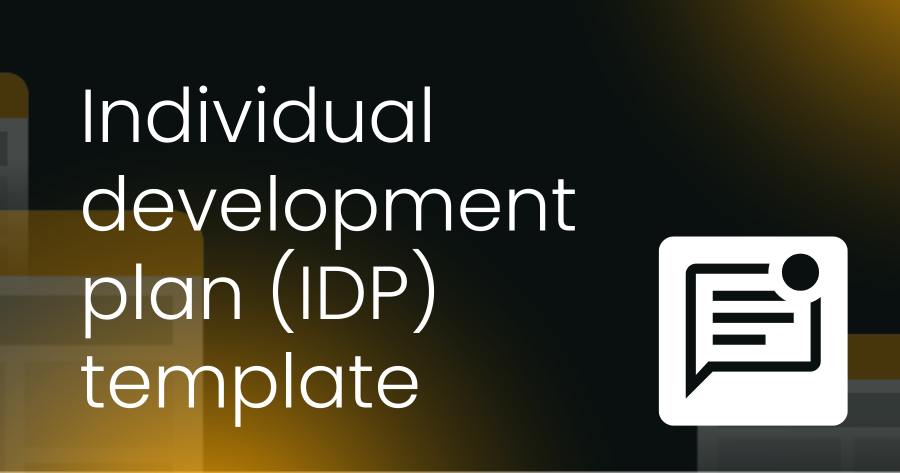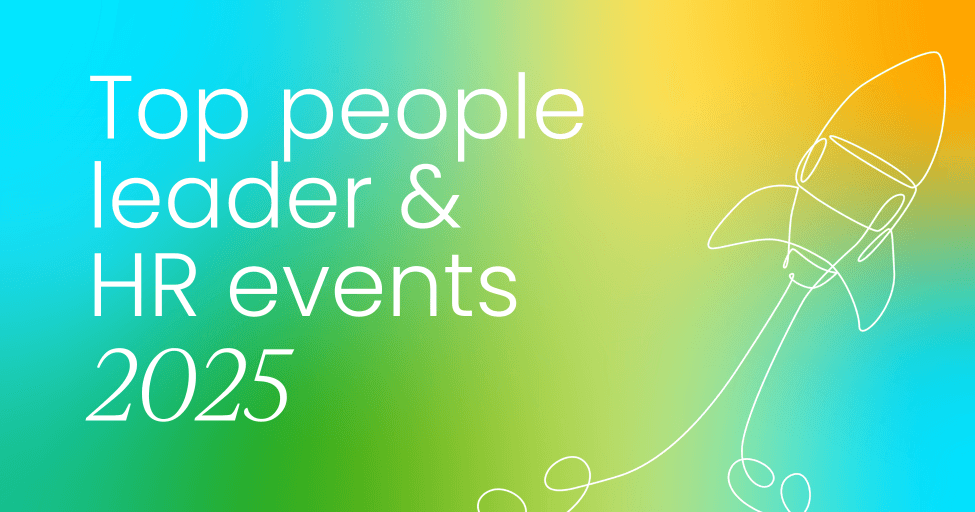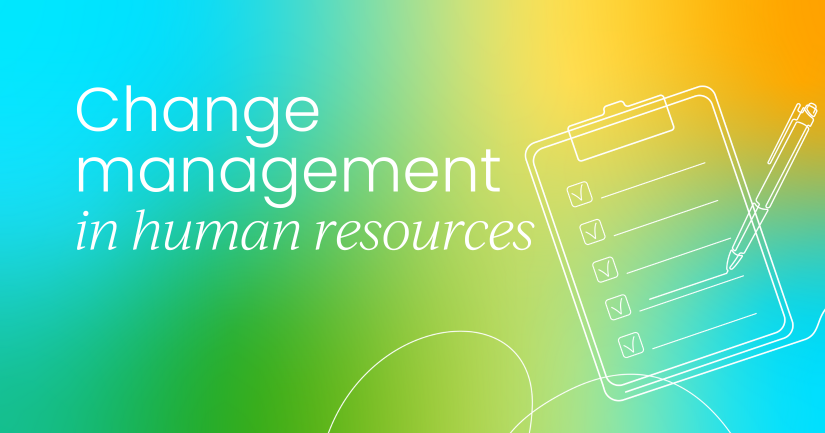Ever feel like the success of a major company change rests squarely on your shoulders? 😅
If you’re in HR or people leadership, you're not exactly wrong. When managed well, change management in HR can inspire growth, strengthen culture, and unlock potential you didn’t know existed. On the flip side, a poorly handled transition can lead to confusion, lost trust, and even top talent walking out the door.
So, what is HR’s role in change management? And how can you turn a moment of chaos into an opportunity for growth?
In this guide, we'll break down exactly how you can become the architect of a smooth and successful change - step by step, with practical strategies you can put into action right away.
What is HR change management?
HR change management is the process of helping people navigate and adapt to transitions while keeping disruption to a minimum. Think of it as the human-centred strategy behind every new process, system, or company shift.
While traditional change management focuses on the project itself, the HR role in change management is all about the people. It involves:
- Preparing people: Assessing employee readiness, understanding their concerns, and making sure they're on board.
- Supporting them through the change: Providing the right communication, training, and resources to navigate the transition.
- Reinforcing the new normal: Ensuring the change sticks by tracking progress, celebrating wins, and addressing any lingering issues.
Change management in HR isn’t just about managing the actual change itself but managing the human experience of that change. It’s the difference between a new system rollout that everyone dreads and one that employees actually embrace.
Why change management matters in human resource management
Change isn’t just an operational challenge, it’s a people challenge. And when the “people side” of change is ignored, even the most brilliant strategies can stall or even fail.
When change is rushed, unclear, or unsupported, it can quickly erode trust and morale. Employees may resist the new direction, productivity can dip, and confusion can ripple across teams. In more severe cases, poor change management can even result in a noticeable increase in turnover.
Done right, change management helps employees feel informed, prepared, and valued. Transparent communication reduces anxiety, training builds competence, and ongoing support fosters confidence.
This combination boosts engagement and helps retain talent, even during periods of uncertainty, because employees can see their role in the bigger picture.
Here are some more reasons why HR change management matters:
- It boosts employee retention & morale.
- It drives project success.
- It builds a resilient culture.
- It protects your employer brand.
In short, a strong focus on change management in human resource management isn't just a best practice. It's a strategic necessity that protects your people and your business.

The role of HR in change management
HR plays a very important role in change management. They’re the ones connecting the business goals with the people who make it happen.
So, if you’re in an HR role and want to learn more about the key hats you wear when it’s time to manage change at work, here are a few to keep in mind:
1. Assess organizational and employee readiness
Before any major change rolls out, you've got to take the pulse of the workforce. This isn't about guessing though. You’ll need to gather feedback to help better understand employee concerns and identify potential skill or knowledge gaps. Readiness assessments help you spot resistance early and address it before it can turn into a bigger problem.
2. Monitor legal and compliance requirements
Change can trigger shifts in labor laws, contracts, or workplace policies. One of your most crucial roles is to ensure all changes meet legal standards and protect the organization from costly compliance risks. This is especially vital during restructures, mergers, or tech rollouts that affect employee data.
3. Craft and communicate a clear change narrative
If employees don't understand why a change is happening, they're far less likely to embrace it. Your job is to help leadership articulate a clear, consistent story about the change - what’s happening, why it matters, and how it impacts each team. This is the difference between an announcement and an inspiring vision.
4. Coordinate and deliver training
Even the best change strategy will fail if employees don’t have the skills to work in the new way. HR designs and delivers targeted training programs that build competence and confidence, from onboarding a new process to upskilling for a new system.
5. Provide ongoing support and feedback channels
Change isn't a one-and-done event but more of a process. HR sets up support resources, whether it's an FAQ page, a dedicated help desk, or regular check-ins, to guide employees through the adjustment period. Just as important is creating feedback loops so employees feel heard, and their concerns are addressed in real time.
6. Measure and review change outcomes
Finally, you need to track how well the change is landing. This could mean analyzing employee engagement data, turnover rates, productivity metrics, or feedback surveys. Regular reviews ensure the change delivers the intended results and helps you identify where further tweaks are needed.
Common challenges in HR-led change management
Even with the best intentions, change initiatives can hit roadblocks. For HR, knowing these challenges in advance means you can plan for them instead of being caught off guard.
Here are a few of the most frequent hurdles that HR pros face:
1. Employee resistance
People naturally resist the unfamiliar, especially if they fear it might make their job harder or less secure. In some cases, the company culture itself can act as a barrier if it’s deeply rooted in “the way we’ve always done things.” Your job is to manage that fear with empathy and clear communication.
2. Communication gaps
If messages about change are inconsistent, overly technical, or slow to reach employees, confusion can spread fast. When employees don’t get the full picture, they often fill in the blanks themselves, sometimes with misinformation.
3. Misalignment between leadership and staff
When leaders say one thing but act differently, trust can start to fade. Employees pick up on mixed messages, which can undermine the credibility of the entire change effort. It’s very difficult to lead a change from the ground up without support from the top. So, make sure you get leadership buy-in ahead of any big changes.
4. Change fatigue
When teams are hit with back-to-back changes without enough time to stabilize, they can get exhausted. Employees may disengage or even actively resist simply because they’re tired of “yet another new thing.” This is a real phenomenon, and it's something HR needs to watch for.
5. Limited resources or budget
Training, technology, and communication campaigns all require investment. Without adequate funding or staffing, even the best change plans can lose momentum and fizzle out before they have a chance to succeed.

Strategies for HR to successfully facilitate change
Challenges are inevitable, but they’re not insurmountable. With the right strategies, HR can lead change in a way that keeps employees engaged, reduces resistance, and delivers real results.
Keep reading to learn about some of the best ways HR teams can facilitate change:
1. Build a structured change management framework
Rather than approaching change ad hoc, adopt a proven framework like ADKAR (Awareness, Desire, Knowledge, Ability, Reinforcement) or Kotter’s 8-Step Process.
A consistent approach helps everyone understand what’s coming next and what’s expected of them. Your plan should include:
- Change assessment: What’s happening and why it matters.
- Stakeholder map: Who’s involved, their role, and how to support them.
- Challenge forecast: Anticipate obstacles and prepare mitigation steps.
- Desired outcomes: Clear goals and success measures.
- Communications plan: Key messages, timing, and channels.
- Training plan: Skill-building, onboarding, or re-skilling programs.
- Sponsor plan: How executives will visibly support and communicate the change.
- Manager enablement plan: Tools, scripts, and training for people managers to guide their teams.
2. Get involved before plans are finalized
Change management is a lot easier when HR is at the table from day one. Early involvement gives you the inside track on:
- What the change is.
- Why it’s necessary.
- How it'll improve the business.
- Who it'll affect, and in what ways.
With this information upfront, you can prepare tailored communication, training, and support strategies before the change even begins. This proactive approach reduces surprises, builds trust, and allows you to flag potential people-related challenges earlier.
3. Leverage HR analytics to guide decisions
Data is your friend during change. Use engagement surveys, performance metrics, and turnover trends to spot areas of resistance or identify where extra support is needed.
You can then use these insights to identify resistance hotspots, measure adoption rates, and make data-driven adjustments. Evidence-based insights like this help HR focus resources where they’ll have the most impact.
4. Engage managers as change champions
Managers are often the first point of contact for employees with questions or concerns. When they're equipped and confident, employees are far more likely to follow their lead. Give managers the tools and training to:
- Explain the “why” behind the change.
- Address concerns with empathy and clarity.
- Keep teams motivated and focused.
5. Create a cross-functional change management network
Change isn’t an HR-only job. Build a change network made up of HR leaders, department managers, and key stakeholders from the C-suite.
Not sure who to involve? Try to select members who:
- Know the organization’s culture inside out.
- Are respected and trusted within their teams.
- Have a proven track record of collaboration.
This network becomes your built-in coalition for planning, communication, and problem-solving. They provide department-specific insights, help cascade messages to employees, and give feedback from the front lines so you can adjust strategies in real time.

Examples of HR change management in action
Change takes many forms in the workplace, and HR’s role is to guide employees through each one with clarity and confidence. There are a few examples of HR change management in action:
Rolling out a new HRIS
Let's start with a classic: the rollout of a new HR information system (HRIS). You might assume this is more of an IT project, but it also touches things like payroll, benefits, and performance reviews, which all impact the overall employee experience.
HR leads this effort by:
- Explaining the "why": We get ahead of the "if it ain't broke, don't fix it" mindset by clearly communicating the strategic reasons for the upgrade (e.g., better data, more efficient processes).
- Providing hands-on training: We move beyond basic guides by delivering targeted training sessions that build confidence and competence with the new tools.
- Creating ongoing support: We don't just "launch and leave." We set up dedicated support channels, like help desks or FAQs, to troubleshoot issues quickly and ensure the transition is as smooth as possible.
With the right preparation, the transition becomes less about disruption and more about a real improvement for everyone.
Mergers and acquisitions (M&A)
These moments can bring a ton of uncertainty about job security, company culture, and leadership priorities. People are naturally worried. HR steps in to bridge that gap and create a sense of stability.
HR’s key actions include:
- Aligning policies and blending cultures: We work to harmonize two distinct organizations, making sure everyone feels like they're a part of the new, unified company.
- Ensuring transparent communication: We host regular Q&A sessions and form integration teams to ensure employees feel informed rather than left in the dark.
- Reinforcing a shared vision: By highlighting the shared future, we help employees see themselves in the new organization and commit to its success.
Shifting to a hybrid work model
Even seemingly simple shifts, like moving to a hybrid work model, require careful change management.
HR sets the stage for success by crafting clear guidelines and preparing managers to lead hybrid teams effectively.
By collecting feedback and fine-tuning the approach, we strike a balance of structure and adaptability that maintains productivity while easing employee concerns.
Cultural change initiatives (e.g., DEI)
Cultural changes, such as launching a diversity, equity, and inclusion (DEI) initiative, demand a similar level of attention. HR takes the lead in setting measurable goals, delivering impactful training, and embedding inclusivity into policies and everyday practices.
Consistent updates and visible leadership support signal that DEI is not just a program - it’s a core value of the organization.
What's next?
Change in the workplace is inevitable, but chaos doesn't have to be. HR's influence is what turns moments of uncertainty into opportunities for growth, innovation, and stronger employee connections.
By getting involved early, building strong networks, and keeping communication open, you don't just manage the transition, you build a culture of adaptability. And in today’s fast-moving business world, that resilience is a competitive advantage.
With HR at the helm of change management, your organization can stride confidently into the future, ready for whatever comes next.
Let’s keep the conversation going
Our events are designed for people leaders who want to think differently, ask the tough questions, and connect with others navigating the same changes in the world of work.
And yes, we've got a lot of upcoming events and sessions on leveraging AI in HR, what to avoid, how to do it right, and so much more.
Check out our upcoming events and come join the conversation. We’d love to see you there!



 Follow us on LinkedIn
Follow us on LinkedIn



